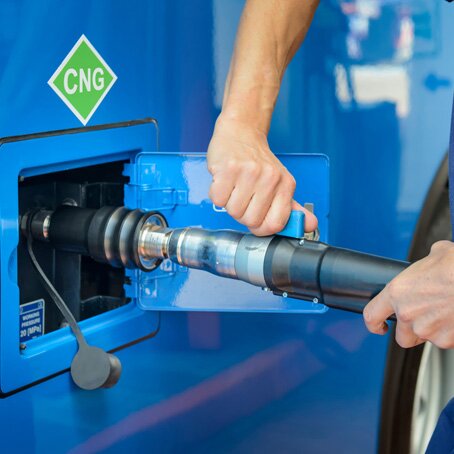An Introduction to Compressed Natural Gas Vehicles

More and more, the world is taking advantage of the benefits of using compressed natural gas (CNG) as a fuel for an array of transportation needs. But CNG currently presents a few challenges when we consider its widespread use for people in their everyday personal lives. Some have been able to overcome these obstacles, of course, but these challenges are why we mostly see CNG vehicles today used in more commercial forms of transportation. In this week’s blog, let’s take a closer look at CNG and some of its pros and cons in meeting the world’s ever-growing need for alternative fuels.
What is compressed natural gas (CNG)?
Just like its name suggests, CNG is natural gas that’s been compressed to high pressure, which makes this efficient form of fuel easier to store and transport. Regarded today as a clean, efficient bridge fuel, natural gas itself is made up of methane, hydrocarbons, carbon dioxide and other trace elements.
Who uses compressed natural gas vehicles?
As we mentioned above (and elaborate on below) there are still a few challenges when it comes to widespread personal use of CNG vehicles, though they are in use for this purpose. Typically today, you’ll find them used by public transit agencies, delivery services, long-haul trucking companies, airports, waste management companies and by federal, state and local government agencies.
Worldwide, use of CNG vehicles is largest in parts of the Middle East and South America, though it continues to grow in parts of Europe, Central America, Asia and the U.S.
What are the advantages and drawbacks of using a compressed natural gas vehicle?
When we consider the advantages of CNG vehicles, we see they’re better for the environment than more traditional vehicles that run on gasoline or diesel—CNG vehicles emit less carbon dioxide and greenhouse gas. Readily available in the U.S., CNG is frequently cheaper than gasoline or diesel, too, and the price tends to remain more stable. CNG vehicle engines also tend to run quieter, have a longer lifespan and require less maintenance. All of this means users save time and money while helping out the planet.
So what are the drawbacks? Well, they’re certainly outnumbered by the advantages, as there are only two major challenges. For one, infrastructure isn’t quite where it needs to be yet. And a limited number of CNG fueling stations equates to reduced driving range—mostly a factor for everyday personal use. For two, there simply aren’t as many choices for consumers. In the U.S., we’re accustomed to an array of makes and models produced domestically and overseas when those vehicles run on gasoline or diesel—and they’re widely available. But CNG vehicle manufacturing isn’t yet on par with our more traditional cars and trucks.
Who’s working to promote the use and availability of compressed natural gas?
When it comes to growing the use of CNG vehicles, there are a number of groups and organizations interested in the widespread realization of CNG’s benefits. From government agencies, environmental groups and automotive companies to financial institutions, community groups and energy companies, many are committed to what CNG vehicles offer. And that includes Gas South.
Besides our commitment to investing is sustainable energies like solar—a technology we’ll have invested $60 million toward by the end of 2023—we’re also playing a part in helping to provide fueling stations with CNG, as well as offering specialized rates and consultation services to companies. Read more about Gas South’s commitment to CNG here in this helpful article: Gas South’s CNG Solution.
We hope this blog gave you some helpful insight into the topic of CNG vehicles. Stay tuned to our blogsite and social media posts for more information like this and a variety of other energy-related topics in the near future.
 Help
Help Giving Back
Giving Back My Account
My Account Sign Up
Sign Up











